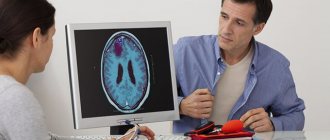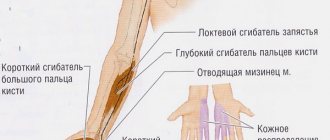Spastic diplegia (Little's disease)
- the most common variant of cerebral palsy, characterized by spastic tetraparesis, more pronounced in the lower extremities. Along with movement disorders, dysfunction of the cranial nerves (strabismus, pseudobulbar syndrome, hearing loss, facial paresis), speech disorders, and, in some cases, mild mental retardation are observed. Diagnosis is carried out using EEG, neurosonography, cerebral MRI, ENMG. Treatment includes pharmacotherapy (nootropics, vascular, neuroprotectors, muscle relaxants), exercise therapy, massage, neuropsychic and speech correction.
Spastic diplegia
Spastic diplegia was first described in 1853 by the English obstetrician Little, who observed the disease in newborns. Little's disease is the most common clinical form of cerebral palsy (CP), detected in half of the cases of this pathology. Children with spastic diplegia make up 40-50% of all students in specialized schools. The disease affects newborns with perinatal trauma, premature babies, and children who were exposed to various unfavorable factors during intrauterine development. Spastic diplegia is detected in the first year of life, most often in the period from newborn to 6 months. The disease is often combined with hyperkinetic syndrome, which occurs in 20-25% of cases of cerebral palsy.
Causes of spastic diplegia
Among the reasons provoking the development of cerebral palsy, modern neurology considers three factors to be the most significant in the etiology of Little’s disease:
- Prematurity
. Premature babies are born as a result of premature birth caused by fetoplacental insufficiency, Rh conflict, premature placental abruption, and uterine anomalies. Premature birth is caused by diseases of the pregnant woman (heart defects, diabetes mellitus, kidney pathology), gestosis (late toxicosis). - Birth trauma of a newborn
. Injury to a child during natural childbirth is possible due to labor anomalies (discoordinated, rapid labor), clinically narrow pelvis, and breech presentation of the fetus. In most cases, complicated births are observed against the background of existing intrauterine pathology. - Asphyxia of the newborn
. Lack of spontaneous breathing at the time of birth is observed when amniotic fluid gets into the respiratory tract, intrauterine infections, fetal development abnormalities, immunological incompatibility of mother and fetus. Asphyxia is possible with pneumopathy, including those associated with immaturity of the respiratory system during prematurity.
Spasticity - what is it? How and why to fight it?
Spasticity or spasmodic syndrome is a painful spasm that can occur after injury or stroke. This phenomenon can play both a positive and negative role. To return to normal life and move comfortably again, you need to take measures from the very beginning of rehabilitation to prevent increased spasticity.
As a result of strokes or injuries, patients may experience cramps and muscle spasms. For example, a spinal injury can lead to cramps in the legs, arms, and cervical spine. Typically, spasms manifest themselves at night, but often make life difficult during the daytime. These involuntary muscle contractions are called spasticity or spastic syndrome.
What is spasticity in simple words?
In a normal state, the mechanism of muscle contraction and relaxation is brought to automaticity. All processes work flawlessly thanks to the coordinated work of the limbs, spinal cord and brain.
But a stroke or injury leads to the death of cells that are responsible for transmitting signals to motor neurons in the spinal cord and brain.
As a result, the inhibitory impulses do not reach the recipient - coordination is disrupted.
In other words, the muscles in the legs or arms have lost connection with the brain, but they continue to store energy. But this energy must be expended - this happens in the form of painful spasms. Since the muscles do not perceive direct commands from the brain, spasms can occur at any moment.
Spasticity: good or bad?
The mechanisms of the formation of spastic syndrome are still not well understood due to their complexity and versatility. Spasticity does not affect everyone. Both its presence and its absence have their pros and cons.
Spasticity keeps muscles toned and promotes good blood supply. Many doctors are very positive about spasticity - it means that the legs or arms can still be restored and the person can walk again.
Even despite the pain, many patients are happy to perceive that their legs (or arms) “work,” albeit spontaneously. At least at the first stage of rehabilitation, the role of spasticity is clearly positive.
But in the future, the strengthening of spastic syndrome leads to serious difficulties in recovery.
How not to trigger spasticity?
If in the first weeks of rehabilitation you take the necessary measures against increased spasticity, you can reduce possible negative consequences. At the very least, you will be able to achieve a state where you can move comfortably and live a normal life. To do this you need:
- Reduce time spent sitting. Of course, you need to sit, including to strengthen your back muscles. You just can’t spend too much time in a sitting position - this leads to contraction and tightening (and therefore loss of elasticity) of the inguinal and abdominal muscles and tendons.
- Lie with a cushion under your chest. The patient spent some time sitting, and now he needs to lie down, placing a cushion under his chest. A regular pillow will do. This is necessary to stretch the muscles after contraction. In addition, it will be useful to place a small load on the tailbone (up to 5-8 kg, selected individually). Additionally, you can place a cushion (or pillow) just above the knee.
- Do not lie on your side with your legs bent. Essentially the same harm as sitting. If this position is comfortable for the patient, then, of course, one cannot refuse it. You need to introduce yourself a mandatory rule: every time after this you need to lie on your stomach with a pillow or cushion under your chest.
- Do not pump up the muscles at the beginning of recovery. At the start of rehabilitation, you want to do as much as possible to speed up recovery. But this approach carries serious risks. Due to spasticity, the muscles are already clogged, and training only makes the situation worse. The path of inhibitory impulses to the addressee becomes even more difficult due to severe muscle congestion.
Treatment methods
It will not be possible to completely get rid of spastic syndrome, but you can make sure that the spasms bother you as little as possible and do not interfere with your everyday life. There are several areas of treatment:
- Therapeutic physical education (physical therapy). In fact, it is the only truly effective method of combating spasticity that gives lasting results. You need to regularly perform a set of muscle stretching exercises: stretch your toes, do circular rotations with your feet, straighten and bend your legs in a sitting position, bend your torso, lift your legs one by one, bend your knees in a position on your stomach. For exercise therapy, you can and should use various auxiliary equipment: balls, benches, hand controls, various exercise machines and other useful devices.
- Surgical procedures. There is a temporary solution that surgeons can offer - tendon trimming. For a while, the spastic syndrome actually disappears, but then it returns and becomes even stronger. Do not rush to agree to this operation until you weigh the pros and cons.
- Pills or injections. Medications can calm painful cramps. But the duration of action of drugs usually does not exceed 2-3 hours, and after prolonged use the drugs will become completely ineffective. In addition, due to medications, spastic manifestations can become stronger and more intense.
Exercise therapy and lying on your stomach with a pillow under your chest are the simplest and at the same time the most effective means against increasing spasticity. This treatment has no side effects or risks.
In addition, if a person with a disability buys technical means of rehabilitation himself, then he can receive compensation from the state for their cost through social services.
For more detailed information, please contact our consultants.
Source: https://www.istok-reatech.ru/info/articles/2017/spastika_chto_eto_takoe_kak_i_zachem_s_ney_borotsya_/
Pathogenesis
Spastic diplegia is formed as a result of damage to the precentral gyrus, which gives rise to the pyramidal tracts that provide motor function. In 30-40%, Little's disease is combined with damage to the cranial nerves. The development of pathological changes in these cerebral structures occurs predominantly through an ischemic-hypoxic mechanism against the background of immaturity of brain tissue due to prematurity. The main pathogenetic link is fetal hypoxia in the prenatal period or during childbirth (asphyxia, birth trauma). The brain is the most sensitive structure of the human body to hypoxia; pathological changes in it develop within just a few minutes of oxygen starvation. In more rare cases, spastic diplegia occurs as a result of direct damage to the above parts of the brain due to intracranial birth injury.
Classification
According to the severity of clinical symptoms, spastic diplegia is classified into the following forms:
- Mild
- in the first half of the year the child develops normally, later spastic paresis is expressed in the area of the lower extremities, movements in the arms are not limited. The patient is able to move without aids. Mental and mental development is not affected. - Moderate severity
- severe spasticity in the legs makes the patient’s movement possible only with the use of improvised means (crutches, sticks). The cognitive sphere suffers slightly, social adaptation is possible. - Severe
- noticeable from the first days of life. There is pronounced tetraparesis with an accent in the legs. Patients cannot move independently. Social adaptation is impaired.
Symptoms
- Spastic diplegia occurs in most children who suffer from cerebral palsy. However, the first symptoms can be noticed within several months after birth. A child under one year old cannot hold his head or lift it independently. He is not able to roll over on his own, and also does not focus his attention on bright and catchy objects.
- As the baby develops, it does not begin to crawl or sit up independently. He also cannot stand on his feet and does not use the affected limb. If a baby exhibits at least a few of the listed signs, you will need to immediately consult a doctor for diagnosis. The sooner therapy is started, the faster the patient’s condition will improve.
- In older children, you may notice that sudden movements are replaced by sluggish actions. There is uncontrolled muscle contraction that occurs from time to time. The child performs unnecessary movements because he cannot fully control his limbs.
- Quite often, children with Little's disease experience a delay in mental and mental development. Dysarthria may appear, that is, speech is impaired, words become illegible even for parents. When pathologies of the cranial nerves are observed, the child develops strabismus, atrophy of visual function occurs, and hearing is significantly impaired. With this disease, a decrease in intellectual function may occur, which becomes especially noticeable as the baby develops.
- It should be noted that spasticity is considered the main sign of paralysis. It is a movement disorder in which muscle tone and tendon reflexes increase.
- If symptoms of the disease appear, you will need to undergo diagnostics. Only after examinations will it be possible to make an unambiguous diagnosis and select a suitable treatment regimen.
Symptoms of spastic diplegia
A typical manifestation of the disease is spastic tetraparesis with predominant damage to the lower extremities. Muscular hypertonicity, which holds the limbs in a bent and adducted state, is necessary for the fetus during its stay in the uterine cavity. After birth, it gradually weakens and normally disappears by the age of 4-6 months. Severe spastic diplegia is characterized by hypertonicity that exceeds the age norm and does not decrease over time. Severe forms are noticeable from birth: during swaddling, children are inactive, attempts to passively flex/extend the limbs meet strong resistance due to sharply increased muscle tone. In mild forms of the disease, the child’s development in the first six months corresponds to age norms; hypertonicity becomes clearly visible after 6 months of age.
Hypertonicity is most pronounced in the foot flexor muscles and hip adductors. The characteristic position of the legs of a sick child is formed: the hips are rotated inward, the knees are connected, the shins are pressed or crossed. The development of the motor sphere is delayed, children begin to walk by the age of 3-4 years. A typical gait is on the toes with extended, adducted legs. When walking, your knees rub against each other. The upper limbs suffer much less, the tone is not increased so significantly, movements are preserved.
The pathology of the cranial nerves is represented by oculomotor disorders, strabismus, decreased visual acuity, hearing loss, smoothness of the nasolabial folds, and deviation of the tongue from the midline. Pseudobulbar palsy is observed, caused by damage to the caudal group of nerves (glossopharyngeal, vagus, hypoglossal). His clinical picture includes dysarthria, swallowing disorders, and hoarseness. There are no sensory disorders, the function of the pelvic organs is preserved. Speech disorders in the form of delayed speech development and dysarthria are observed in 75-80% of patients.
In a quarter of cases, spastic diplegia occurs with hyperkinesis. Involuntary movements in the form of athetosis, choreoathetosis are localized in the distal parts of the upper extremities, intensify with voluntary movements, emotional stress, weaken at rest, and are absent during sleep. Mental development suffers less than with other types of cerebral palsy. Oligophrenia is observed in 20-25% of patients; its severity does not go beyond debility.
Basic exercise therapy for lower limb paresis
- Basic exercises
- When to do it
- Contraindications
Paresis of the lower extremities is a pathological condition that is associated with weakness of certain muscles.
The main reason for this is a disruption in the connections between muscle fibers and the nervous system.
Moreover, paresis is not an independent disease, but a consequence of some pathology, for example, stroke, multiple sclerosis, spinal cord injury or trauma.
Therefore, it should be understood that treatment of paresis should never be carried out separately from the treatment of the disease that caused this condition. Along with exercise therapy, for paresis of the lower extremities, the doctor prescribes medication, massage and physiotherapy.
Basic exercises
The exercises performed will depend on which muscles are damaged. However, there are a number of universal exercises that all patients with this diagnosis can perform.
- Lying on your back. Raise your right leg and inhale, lower your right leg and exhale. Do the same movements with the other leg.
- Also on the back. Bend one leg at the knee and pull it as tightly as possible into the chest. Remain in this position for a while, then extend your leg. Repeat with the other leg as well.
- Lying on your back. Draw circles in the air, first with one leg, then with the other.
- Raising and lowering your legs using a block. It is important to monitor your breathing. When raising your legs, inhale, and when returning to the starting position, exhale.
- On the back. Turn the body to the right or left side, throwing the opposite leg to the side.
- Imitate swimming - make movements with your legs as in the water when swimming breaststroke.
- Lying on your back. Raise your leg and draw a circle in the air with your toe. Then repeat with the other leg.
- Lying on your back, bend and straighten your toes. In this case, you must try to follow the sequence, that is, first bend the fifth finger, then the fourth, then the third, second and first. When extending, it is advisable to spread your toes.
- Lying on your back. Pull your feet towards you. You can do it one at a time, or you can do it with both legs at the same time.
- Turn your feet left and right. Can be performed both lying down and sitting.
- Bend and straighten your legs at the knee.
- Lying on your back. Pull the foot of the right foot towards you, the foot of the left foot away from you.
Do all exercises very slowly; if you feel unwell, it is better to cancel all exercises. To perform passive movements, you need to use additional devices. This may also require the assistance of an instructor.
The total duration of classes should not be more than 15 - 20 minutes, for weakened patients and bedridden patients - no more than 10 minutes. Each exercise must be repeated 3 to 4 times.
In this case, the patient should not experience fatigue, shortness of breath, or other signs that could negatively affect his health.
When to do it
The peculiarity of exercise therapy is that you can perform exercises at almost any time of the day. This could be morning exercises, which have a significant positive effect on the body. Moreover, if the patient cannot get out of bed, he can perform them while lying down.
This can be an independent activity, which can also be done at home.
These can be classes in specialized exercise therapy centers, under the supervision of an instructor. In this case, breathing exercises will be performed first, then the main ones, and the final part, which includes relaxation exercises.
This can be measured walking in the fresh air, or measured ascents and descents along specially laid routes.
Contraindications
Physical therapy may not always be prescribed for paresis of the limbs. This procedure, like many others related to human health, has its own contraindications, which must be remembered.
For example, the main contraindications should be considered lack of contact with the patient due to certain mental disorders. Classes cannot be conducted in case of infectious diseases or intoxication. You should also postpone exercises when the patient complains of pain.
Other contraindications include:
- Thrombosis or risk of thrombosis.
- Embolism or risk of embolism.
- Bleeding or threat of bleeding.
- Increased body temperature.
- Increased ESR.
- High blood pressure, especially when the numbers are 200 to 120 and above.
- All malignant neoplasms.
- Metastases.
This means that before you start practicing, you must consult with a specialist.
Source: https://vashaspina.ru/osnovnye-uprazhneniya-lfk-pri-pareze-nizhnix-konechnostej/
Diagnostics
Spastic diplegia is diagnosed by a pediatric neurologist, taking into account the consultation opinions of related specialists (pediatrician, pediatric ophthalmologist, otolaryngologist). Great importance is attached to the presence in the anamnesis of indications of pathology of the antenatal period, prematurity, birth trauma, and asphyxia during childbirth. The list of diagnostic examinations includes:
- Neurological examination
. Detects increased muscle tone of the central type, increased tendon reflexes (especially knee and Achilles), foot clonus, Babinsky's pyramidal foot signs, Rossolimo, hyperkinesis, pathology of the cranial nerves. - Ophthalmological examination
. Diagnoses strabismus and oculomotor disorders. Visometry determines a decrease in visual acuity. Ophthalmoscopy may reveal signs of optic nerve atrophy. - Consultation with an otolaryngologist
with audiometry. Necessary to determine the degree of hearing impairment. - Electroencephalography
. Reflects the state of bioelectrical activity of the brain. Epileptiform changes are uncharacteristic. - Electroneuromyography
. Prescribed to differentiate Little's disease from neuromuscular diseases. - Neurosonography
. Using ultrasound, cerebral structures are visualized through an open fontanel. The technique allows us to exclude congenital brain anomalies, hydrocephalus, tumors, cerebral cysts, and post-traumatic intracranial hematomas. - MRI of the brain
. It is carried out in diagnostically doubtful cases for children with an already closed fontanel. More accurately than ultrasound, it reflects intracranial changes. - Diagnostics of mental development
. At an early age it is carried out by a neurologist, later by a child psychiatrist. Aimed at identifying mental retardation and mental retardation.
Little's disease is differentiated from other forms of cerebral palsy, abnormalities of the central nervous system, progressive degenerative lesions of the central nervous system, hereditary diseases, and dysmetabolic diseases. As part of differential diagnosis, a consultation with a geneticist and a study of the biochemical composition of blood and urine may be required.
Treatment of spastic diplegia
Specific etiopathogenetic therapy for cerebral palsy has not been developed. Medication and rehabilitation treatment is carried out aimed at preventing complications, teaching self-care skills, and improving social adaptation. Drug treatment includes:
- Vascular agents
(cinnarizine) - improve cerebral circulation and nutrition of brain tissue. - Neurometabolites
(glycine, pantothenic acid, thiamine, pyridoxine) provide substances necessary for the functioning of the central nervous system. - Muscle relaxants
(baclofen) - reduce muscle spasticity. - Nootropics
(piracetam) - activate cognitive functions. - Botulinum toxin preparations
are administered intramuscularly to relieve spastic tension and prevent the occurrence of contractures.
Rehabilitation therapy consists of:
- Physiotherapy.
It is carried out by a physical therapy doctor and independently by the patient’s parents. Includes passive, active movements, exercises on special simulators. It is necessary daily to maintain range of motion and prevent complications. - Massage
- improves blood supply to affected muscles. Myofascial massage helps relax muscles. - Correction of speech disorders
. Speech therapy classes for the correction of dysarthria and speech therapy massage are conducted. - Correction of mental disorders
. Required in case of mental retardation. It is carried out through neuropsychological correction, classes with a psychologist, speech pathologist, and play therapy. Older children are taught by special education teachers in specialized schools.
Treatment of Little's syndrome
It is impossible to cure spastic diplegia - you can only soften muscle damage and prepare the child as much as possible for adaptation to social life.
Here, to a greater extent, they resort to general physiotherapeutic rehabilitation procedures, which are prescribed in accordance with the form of the disease and its course.
Possible treatment methods include:
- Massage – professional regular massage improves blood circulation, which prevents the development of contractures and reduces muscle tone. This allows the child to move better.
- Exercise therapy - therapeutic physical education in the presence of cerebral palsy is mandatory. Exercises are selected individually, taking into account the physiological capabilities of the child. Modern devices and complexes are often used to allow the child to do exercises better and more endurance without compromising his health.
- Acupuncture - affects receptors, improving blood circulation. Inserting needles into special points helps prevent the rapid development of contractures and partially relieve muscle tone.
- Swimming is a special technique designed for the implementation of swimming movements by children with pathology, which has a positive effect on the general physiological condition.
- Vojta therapy is a technique developed by Czech neurologist Vaclav Vojta. The method is aimed at restoring motor functions by activating reflexes.
- Adele's suit is a sock of a power system consisting of supporting elements and elastic adjustable rods. The suit allows you to fix the correct position of the child, promoting muscle “memory”.
Article on the topic: Pramistar - a nootropic for increasing brain function
Drugs for drug treatment include the use of nootropics (Piracetam, Nicergoline, Caffeine and other drugs) and homeopathic drugs (Spascuprel, Verotrum, Natrium and others).
Drug treatment is carried out in the presence of auxiliary lesions in the form of delayed intellectual and psychological development.
Prognosis and prevention
In terms of the motor sphere, spastic diplegia has a more serious prognosis than the hemiplegic form of cerebral palsy. Only a quarter of patients are able to walk independently; half of the patients move with the help of special aids. With severe tetraparesis, movement is only possible in a wheelchair. With mental integrity and minor changes in the muscles of the upper limbs, the social adaptation of patients approaches that of healthy people. In severe cases, patients require constant care. Proper, regular rehabilitation measures and periodic courses of drug treatment improve the prognosis. Measures to prevent the disease include careful management of pregnancy, prevention of intrauterine pathology, adequate choice of delivery method, and correct management of childbirth.









